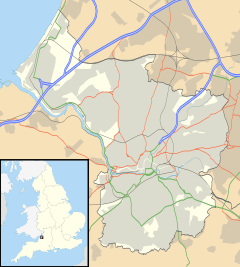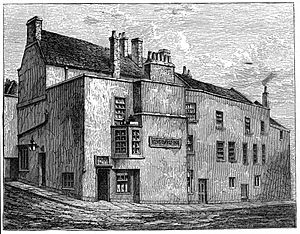St Mary Magdalen Nunnery, Bristol facts for kids
Quick facts for kids St Mary Magdalen Nunnery |
|
|---|---|
| Religion | |
| Affiliation | Roman Catholic |
| District | Kingsdown |
| Ecclesiastical or organizational status | Demolished |
| Location | |
| Location | Bristol, England |
St Mary Magdalen Nunnery (grid reference ST585733) was a special religious house for women called Augustinian canonesses. These women were like nuns who followed the rules of St. Augustine. The nunnery was located in Kingsdown, a part of Bristol, England.
It was started around the year 1173. The nunnery was later closed down in 1536. Today, the name St Mary Magdalen is remembered in Maudlin Street. The nunnery used to be near the corner of Maudlin Street and St Michael's Hill. Later, a building called the King David Inn was built on this very spot.
How the Nunnery Started
The St Mary Magdalen Nunnery was founded by a woman named Eva Fitzharding. She gave the nunnery land in a place called Southmead. Eva Fitzharding also became the very first leader, or prioress, of the nunnery.
We don't know much about her family background. Eva was the wife of Robert Fitzharding. He was a very rich merchant, known as a burgess, from Bristol. Robert Fitzharding became the Lord of Berkeley. He also founded St Augustine's Abbey, which is now Bristol Cathedral. Like his wife, Robert ended his life living as a religious person in the house he had founded.
Life at the Nunnery
From the 1200s onwards, the nunnery was quite poor. Because it didn't have much money, it didn't have to pay taxes. It also didn't have to make payments to the Bishop of Worcester. The nunnery was part of his church area, called a diocese.
In 1480, a man named William Worcester was measuring religious buildings in Bristol. He found that St Mary Magdalen Nunnery had only three nuns living there. He measured their church as being just 27 steps long. Each of his steps was about 21 inches (53 cm) long. Some parts of the nunnery have been found where the King David Inn now stands. These parts show a style of building called Perpendicular.
In 1535, the money earned by religious houses in Bristol was checked. This check was called the Valor Ecclesiasticus. St Mary Magdalen Nunnery had only two nuns and earned about £21 a year. To compare, St Augustine's Abbey had 19 nuns and earned £670 a year. This shows how small and poor St Mary Magdalen Nunnery was.
The Nunnery's Closing Down
The time when many religious houses were closed in England was called the Dissolution of the Monasteries. In 1536, St Mary Magdalen was the only "smaller" religious house in Bristol to be taken over by the King's officials. This happened because of a law called the Act for the Dissolution of the Lesser Monasteries.
The officials found that the nunnery did not owe any money. The building was also in good condition. However, its belongings were only worth a few pounds. The two nuns who lived there had to leave. One was Eleanor Graunt, an older woman who had been the prioress since about 1521. The other was a young nun who was just starting out. They were not given any money to live on, and we don't know what happened to them after the nunnery closed. After that, the nunnery building became a private home.



